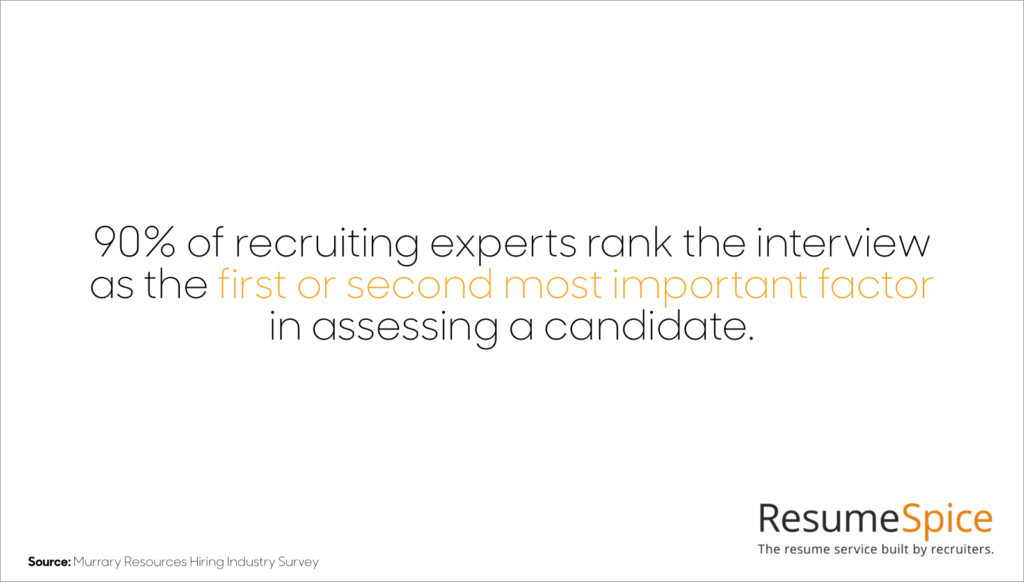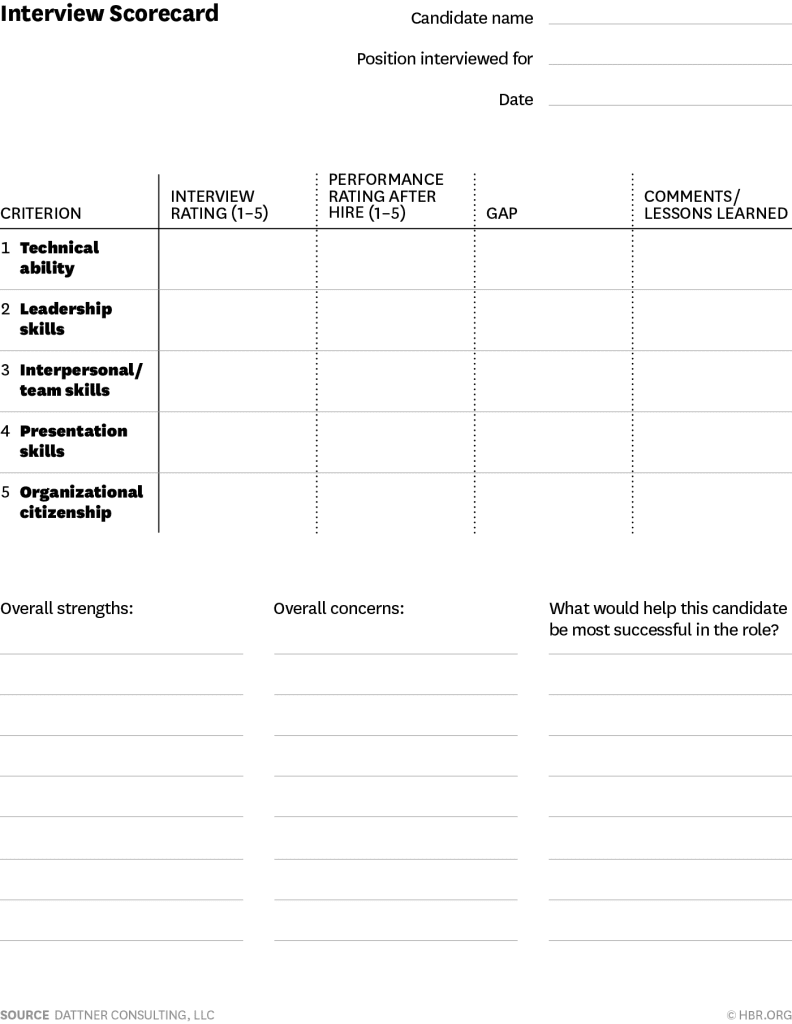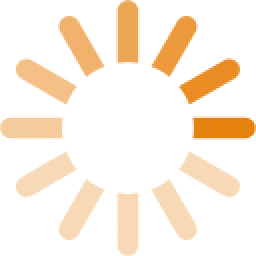Hiring mistakes are costly. In fact, one survey found that companies lost $14,900 on every bad hire in 2017.
Unfortunately, mishires are all too common with 74% of employers saying they've hired the wrong person for a position.
These numbers suggest that steps in the hiring process are flawed. The interview is a top suspect since companies normally lean heavily on interviews to choose a candidate. According to Murray Resources, 90% of survey respondents ranked the interview as the first or second most important factor in the hiring decision.

But unstructured interviews — interviews that have no set list of predetermined questions — are limited in their ability to produce qualified hires. Research suggests that standard, unstructured interviews are one of the worst ways to successfully select the right person for a job.
Here are three problems with relying too much on unstructured interviews and what you can do instead.
Interview Issue #1: Interviewer Bias
Interviewer bias is a common problem with traditional interviews. In fact, 42% of recruiters cite interviewer bias as a challenge. Interviewer bias means that our own conscious or unconscious biases skew our judgment of a candidate and their potential fit for a role.
There are different types of interview bias. For example, similarity bias is when the interviewer likes the interviewee because the person is similar in appearance, interests, background, etc. Confirmation bias is when an interviewer makes a quick decision about an interviewee and confirms that belief throughout the interview, even if it’s inaccurate. Intuition bias is when the interviewer trusts their “gut feeling” about an interviewee, instead of the candidate's skills and experience.
The list goes on, but the damage of interviewer bias is clear. Interviewer bias isn’t only harmful to hiring decisions – it also makes it harder to generate a more inclusive workforce. Considering that a diverse workforce performs better, interviewer bias is worth eliminating.
Interview Issue #2: Top Candidates Aren’t Always the Best Interviewers
A great job candidate doesn’t necessarily equate to a great interviewer. Why? Great candidates with steady tenure don’t interview often. As a result, they don’t have as much practice sharpening their interview skills.
This lack of practice creates a distinct disadvantage for the candidate, especially if a hiring manager is relying on an unstructured interview to make the final hiring decision.

33% of employers say that they decide if they’ll hire a job candidate within the first 90 seconds of an interview. The best candidates might then be overlooked thanks to unpolished interviewing skills.
Interview Issue #3: Job Hoppers Have Extensive Interview Experience
Throughout the interview process, you’ll likely meet job hoppers — employees who regularly change roles every year, unrelated to layoffs, market downturns, or any other factor outside their control.
These employees are skilled interviewers because they have the most practice. They are also easily able to answer tough questions with confidence. Confidence is one of the most admirable traits in a candidate, according to 42% of HR professionals.
Unfortunately, hiring a job hopper can be costly if the candidate repeats their pattern and leaves the company within a year or two. The cost of employee turnover can range from 16%-213% of the lost employee’s salary.
Approach Interviewing Differently
Interviews shouldn’t be eliminated from the hiring process as they provide an excellent opportunity to build relationships and learn more about a candidate. Expectations for a role can also be set within an interview.
However, unstructured interviews are a problem. Here are ways to rethink the structure of an interview and how to better fit interviews within the recruiting process.
Solution #1: Follow a predetermined interview scorecard
A predetermined interview scorecard reduces the potential for bias within an interview. You can develop a baseline of standard interview questions for each skill related to the position, as well as a predetermined grading scale – the process is then fair and objective. All candidates are judged by the same scorecard and grading system.
For example, say that your scorecard has questions to assess a candidate’s leadership skills, culture skills, and technical skills. Each skill has a grading scale from “Low” to “Outstanding” that you can use to score the candidate. Companies like Google use this method as part of their hiring process.

[Source]
Granted, it’s challenging to create scorecards for positions over and over again. It’s why many people don’t adhere to structured interviews. They feel confident in their ability to judge people without guidance. But the truth is, objectivity is needed in the hiring process. Interview scorecards add in a layer of objectivity.
Solution #2: Conduct pre-employment assessments
Pre-employment assessments evaluate candidates based on a consistent rating system. This method is proven to remove bias from the hiring process. It’s also a time-efficient way to screen applicants.
Pre-employment assessments are also called job assessments or skill assessments. Employers use these tools to objectively assess job candidates before they make a hire. These assessments can be cognitive tests (verbal/numerical reasoning), skills assessments (ex: Excel or typing tests), personality assessments (ex: Myers-Briggs), or job fit assessments (ex: Birkman for sales, Predictive Index).
Here’s how the hiring process might work for a sales role, with assessments integrated:
- Sales aptitude assessment (ex: Predictive Index or Birkman)
- 20-minute phone screen with hiring manager
- Personality assessments (ex: DISC)
- 60 minute, in-person interview
- Sales presentation / Blind audition
In this example, steps #1 and #3 serve as objective assessments. Step #2 (the phone screen) helps eliminate some of the natural biases that come with face-to-face meetings.
If a candidate successfully reaches step #4 (the in-person interview), they most likely have the skills and aptitude for the role. The impact of interviewer bias is thus reduced.
Solution #3: Host blind auditions.
Have you ever watched “The Voice?” It’s a singing competition where judges have their backs to the stage. A singer performs and judges select contestants based solely on their voice talent. This method is designed to remove bias. A blind audition works the same way in hiring. It reduces interview bias and reliance on traditional interviewing practices.
Here’s how it works: During a blind audition, you have an applicant complete a job-related task such as writing a case study or finishing a coding challenge. The applicant is then hired based on their merit and skill, rather than solely on an unstructured interview. This hiring method also helps generate a more diverse pool of candidates.
Solution #4: Decide on an area of focus for each interviewer
Unfortunately, too many conversations after an interview go something like this:
Interviewer #1: “What did you think?”
Interviewer #2: “I liked her. I think she could fit well here.”
Interviewer #1: “I think so too. And her experience with XYZ company was great.”
Interviewer #2: “Let’s ask Barbara what she thought.”
Despite this not being the most rigorous evaluation process, it’s far too common.
Here’s how to avoid a simple “thumbs up or thumbs down” hiring decision with the interview team: Give each interviewer a particular area to evaluate such as the interviewee’s culture fit, technical skills, or managerial acumen. Base evaluation assignments on each interviewer’s position within the company.
For example, the HR manager might evaluate managerial skills or culture fit. The hiring manager could evaluate technical skills. By dividing responsibility, all areas of an open interview are evaluated more objectively.
Beyond the Unstructured Interview
There are always mistakes involved in the recruiting and hiring process, but a poor interview system shouldn’t dictate who you hire. You might overlook the most qualified candidates. Introduce a level of consistency and objectivity into your hiring process and step away from the unstructured interview – your chances of mishiring will go down significantly.






